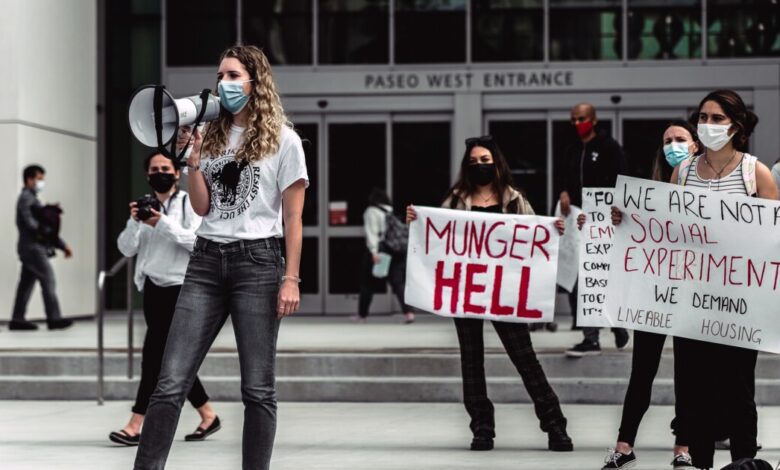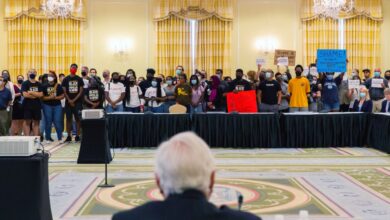Why a California Campus Bursting at the Seams Indulged an Eccentric Donor

The bedrooms, Charlie Munger told the Board of Regents, would have artificial portholes instead of windows — the kind one finds on Disney cruise ships where a “starfish comes by and winks at your kid.”
Harold Marcuse, a professor of history at UCSB, assumed it’d take a decade or more for the massive structure to go through all the approval hoops and that, surely, along the way, the design would change. By then, he figured, Warren Buffett’s right-hand man and vice chair of Buffett’s Berkshire Hathaway conglomerate probably wouldn’t be around to insist his plans be followed to a T.
Today, Munger is 97 and has no interest in relinquishing control of the 1.68-million-square-foot project — one that the university continues to defend even as it’s roundly condemned by many architects, community members, and students. In one fell swoop, Munger Hall could deliver more than 4,500 desperately needed beds to a university under lawmakers’ orders to expand its enrollment, even as it faces legal threats over its housing shortage.
Last month, the City of Goleta announced plans to sue UCSB over its alleged failure to fulfill its promises to provide sufficient student housing for its growing enrollment.
More than 300 students were housed in hotel rooms this fall, and a few resorted to living in their vans because there weren’t enough rooms on campus or in local communities struggling with their own housing crises. In August, the university asked faculty and staff members to consider renting out spare bedrooms to students.
The university “admitted too many people too fast,” Marcuse said. “The campus is bursting at the seams.”
For the past five years, the UC campuses have been under orders from the governor and state legislature
to increase enrollment to make room for the growing number of California residents being turned away. As high-school graduation rates increase, particularly among the state’s burgeoning Hispanic population, record-breaking application numbers are making it harder to get in to a four-year university. For fall 2021, a record 250,000 people applied for freshman or transfer admission to the university’s nine undergraduate campuses — up 16 percent from last year, a university spokesman said. Cecilia V. Estolano, the new chair of the University of California Board of Regents, wants the system to expand even more by 2030.

Al Seib, Los Angeles Times
The problem is that for some of the UC campuses, including Santa Barbara, there’s little room to spread out, and their surrounding communities are pushing back.
As more students spill out into Santa Barbara County neighborhoods, city officials are complaining that working-class residents are being forced out, congestion is worsening, and hotel rooms are being taken off tax rolls.
In Goleta, for instance, an influx of students has put a strain on police and fire departments, pushed housing costs up, and forced more residents to commute long distances to their jobs, the city contends. The typical home price in Goleta has jumped from $793,000 in October 2016 to $1.1 million in October 2021, according to Zillow. In the past year alone, the online realtor reported, the city’s home values rose 26 percent.
But both the city and the university are constrained in their ability to expand because of their location in an environmentally sensitive region wedged between the Pacific coastline and the steeply-rising Santa Ynez Mountains.
In 2010, when it enrolled around 20,000 students, the Santa Barbara campus released a long-range development plan that called for enrollment growth of 1 percent per year through 2025, when it would be capped at 25,000. The plan, negotiated with local communities and the county of Santa Barbara, also promised to provide 5,000 beds to accommodate the university’s growing student population, along with more faculty and staff housing. Since 2015, it has opened two housing projects that, combined, house around 1,500 students. If the Munger Hall plan were scrapped, it would be hard pressed to provide 3,500 more beds.
Goleta’s mayor, Paula Perotte, said in a prepared statement that “the failure of UCSB to meet its obligations” in the 2010 plan “has made us reach a breaking point.” Given the thrashing Munger Hall has taken in the international press — with headlines calling it “dormzilla,” a “torture experiment,” and an “architectural nightmare” — she also expressed doubts about whether the needed housing will be built “in a reasonable time frame.”
The county asserts that the university’s own statistics show it’s already topped the 25,000-student cap.
The university says the long-range plan it agreed to refers to the average enrollment over three quarters and doesn’t include students who are studying abroad or otherwise not physically on campus.
In a Q&A statement released last month, the university said that a mandate from the governor and state legislature “required faster enrollment growth than was originally anticipated.” The Munger Hall project “is a partial fulfillment of our responsibility to our students and to addressing some of the pressures faced by our neighboring communities.”
It’s also attracting plenty of controversy. The blocky, 11-story building would house more than 4,500 students, 94 percent of whom would have small, windowless private bedrooms. The idea is to encourage students to spend their nonsleeping hours mingling, working, and cooking with their suitemates, who would share a kitchen and living space. The top and bottom floors would include such amenities as a fitness center, gastro pub, market, and cafe.
Dennis J. McFadden, a local architect who had advised the university for about 15 years, resigned from the university’s Design Review Committee in protest after the Munger plan was presented as a fait accompli. He called the densely packed dorm potentially destructive to the campus and to students’ mental health.
After word of his resignation letter was leaked out, hundreds of students, employees, and community members gathered last month to protest construction of the dorm and plans to move students out of hotels at the end of the fall semester.
Marcuse, the history professor, was among the protesters. In an interview, he said the state hasn’t provided nearly enough money to cover the costs of the additional students it’s requiring. But he also faults the university for not involving faculty members in the decision to move forward with the unprecedented project. “We had no opportunity for input before this billionaire was able to ram it down UCSB’s throat,” he said.
When told to expand, the university “should have drawn a line in the sand and said no,” Marcuse said. He predicted that, given the backlash against the design, the plan will eventually be modified and the university might lose Munger’s money. (Munger told The Chronicle in an interview that if he had to change the design, he’d take back his donation). But given that it amounts to $200 million out of a project expected to cost more than $1 billion, it wouldn’t necessarily kill the project, Marcuse said. “Even billionaires can’t dictate everything.”
Meanwhile, criticism continues to mount. Last month,, eight former University of California campus architects and officials wrote the system’s president, Michael V. Drake, to call the Munger Hall proposal “a disaster in the making.” The project would be the most expensive residential complex in the university system’s history, they wrote in a letter obtained by the campus newspaper. The small, windowless bedrooms, they added, could have “severe psychological effects” on their residents.
They said they understood that “The community pressure is intense, but this social petri dish, so foreign to the character of the Santa Barbara campus, is not the answer.”
The university responded with a statement calling the complaints “misleading” and saying the design isn’t complete and the final construction costs aren’t yet known. Unlike most dorms, Munger Hall “provides substantially more common areas, amenities, and even spaces for academic use, which ultimately translates to cost.”
In its Q&A statement, the university acknowledged that the living arrangements and virtual windows “may not be right for everyone,” but that students will continue to have plenty of other, more conventional choices.
In an editorial for the campus newspaper, The Daily Nexus, Marc Vukcevich wrote that as a June graduate and former member of the Design Review Committee, he had serious reservations about Munger Hall that go beyond the windowless bedrooms.
“My deep worry is that this building design allows students who are not good at socializing right out of high school or who are depressed or suicidal to self-isolate,” he wrote. Then, there’s the issue of safely evacuating thousands of students each time someone burns their popcorn. “Consider how many times the smoke alarm will go off when you acknowledge how much cannabis UCSB students smoke combined with the chaos of first-years cooking and multiplied by 4,500″ students — mostly 18-year-olds.
Source link






